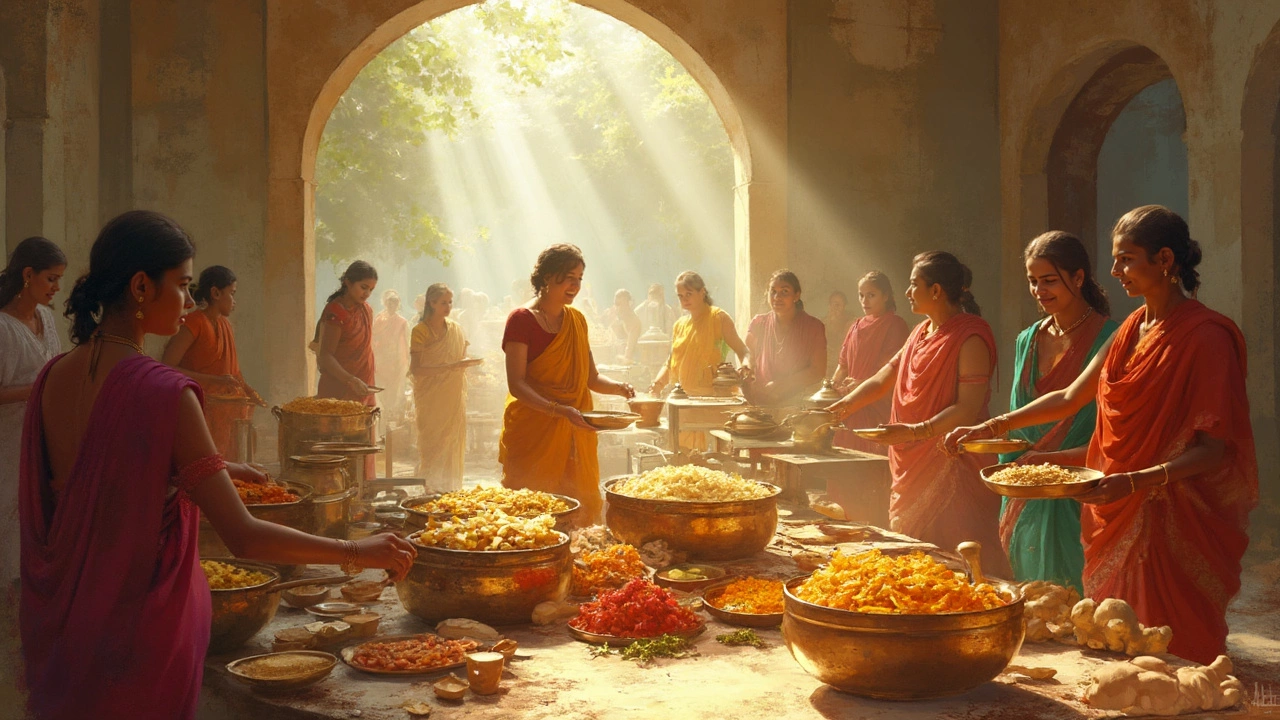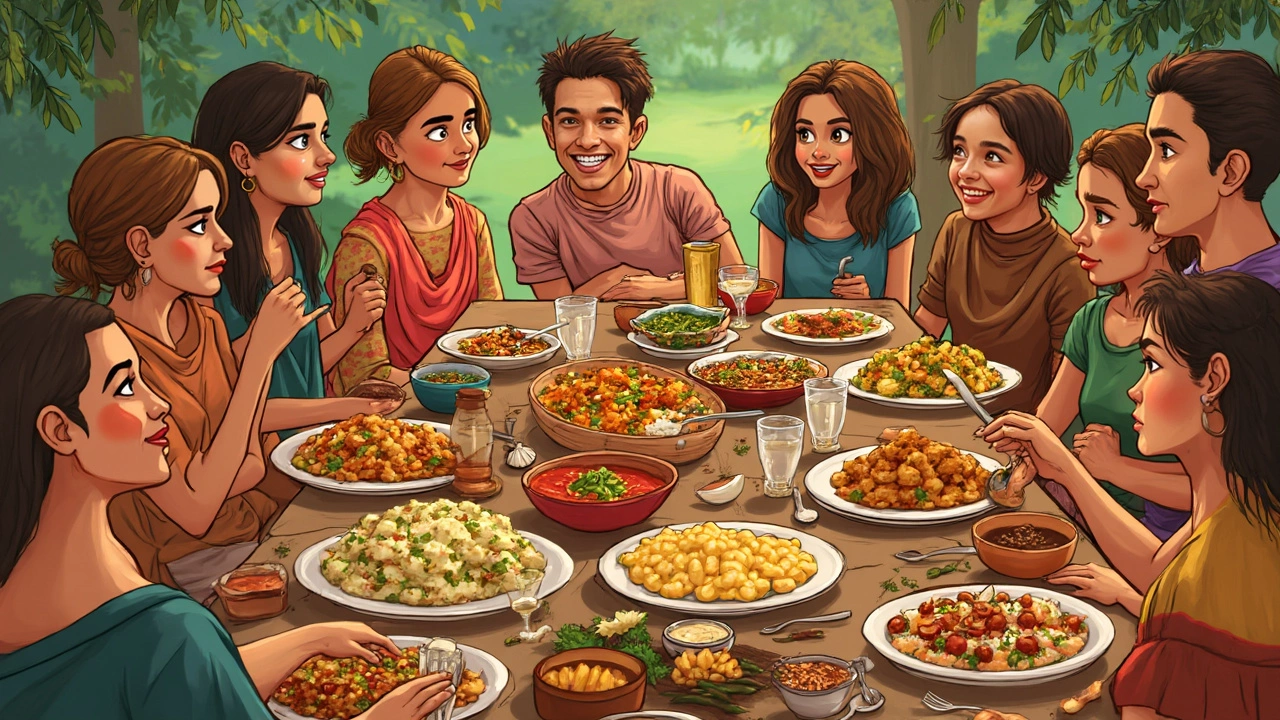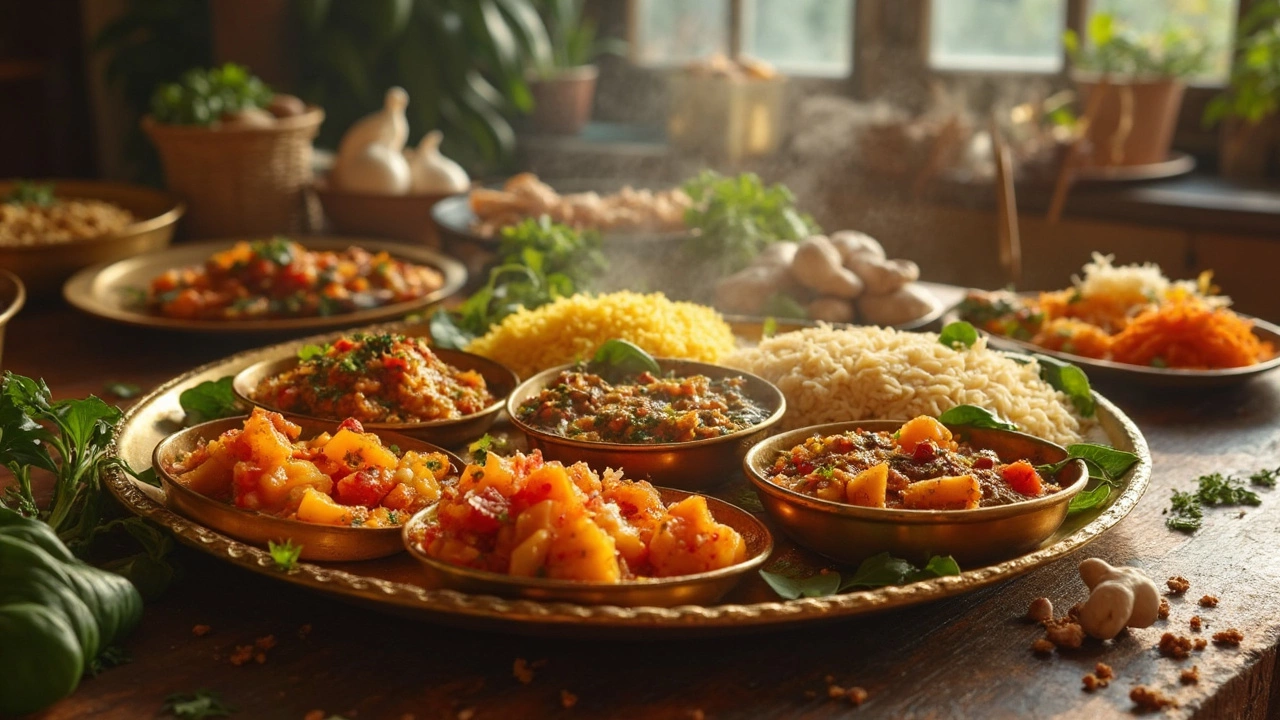Ever tried making Indian food without garlic? For lots of people, that's not just possible—it’s their daily way of eating. Garlic seems like it’s in everything from dals to chutneys, but across India, some folks skip it for strict religious, health, or personal reasons. Jain cuisine is probably the biggest example—think delicious curries, vibrant sabzis, and hearty dals, all made without a trace of garlic or even onion.
You may be surprised just how common garlic-free vegetarian food is at Indian weddings, temples, and festivals. For allergy sufferers or anyone avoiding strong flavors, these meals are seriously underrated. Want flavorful sambar, paneer bhurji, or even pav bhaji without garlic? There are easy swaps and clever tricks for every recipe. If you need inspiration or guidance, you’re definitely not alone.
- Why Skip Garlic in Indian Cooking?
- Jain Cuisine: The Biggest Garlic-Free Zone
- Other Indian Communities Avoiding Garlic
- Top Vegetarian Dishes Without Garlic
- Tips for Cooking Flavorful Meals Without Garlic
Why Skip Garlic in Indian Cooking?
Most people think of Indian cuisine and instantly picture dishes packed with garlic. But garlic isn’t a must-have for everyone. There are clear reasons why plenty of Indian households and entire communities leave it out. The most obvious is religion. Jainism, for example, is strict about diet and completely avoids garlic, onion, and root vegetables because pulling them from the ground is thought to harm tiny living things, and these are considered to boost passion and aggression, not great for meditation or peace.
Hindu traditions have similar beliefs around holy days or religious fasts, when eating "satvik" food is common. Satvik food means pure, simple ingredients—so no garlic or onions. Certain Vaishnav and Brahmin communities follow this year-round, not just for special occasions. It’s about keeping meals calming and light, not stimulating or heavy, perfect for prayer or yoga.
Health reasons pop up, too. A few folks say garlic is just too powerful for their system, causing digestive issues or even allergies. Ayurveda, India’s traditional health system, sometimes labels garlic as "rajasic" (overstimulating for the mind), so followers looking for balance might avoid it altogether.
| Garlic Usage in Select Indian Communities | % People Avoiding Garlic |
|---|---|
| Jain | 99% |
| Brahmin (certain regions) | 60% |
| Vaishnav | 80% |
Celebrations and temple foods are another big reason you’ll find garlic-free recipes. In temples, prasad (the food offered to the gods and given to devotees) never contains garlic or onion, sticking to simple ingredients like pulses, grains, and veggies.
If you’re exploring vegetarian Indian dishes or just want to change things up, remember skipping garlic isn’t as weird as it sounds—it’s a regular thing for millions of people every day.
Jain Cuisine: The Biggest Garlic-Free Zone
If you’re looking for vegetarian Indian dishes without garlic, Jain food is where you’ll find endless options. Jain cuisine isn’t just garlic-free—it also skips onions, potatoes, and other root veggies. This isn’t just about taste. It comes from deep religious beliefs. Jains follow a philosophy of non-violence, so they avoid anything that involves killing a plant at the root, which means garlic and onions are out.
There's a huge variety of garlic-free recipes in Jain cuisine. Sabzi (dry veggie dishes), dals without onions or garlic, and even street foods like Jain pav bhaji show how creative this cuisine can get. Instead of relying on garlic and onion for flavor, Jain cooks use spices, asafoetida (hing), ginger, and fresh herbs. You won’t feel like you’re missing anything. In cities like Mumbai and Ahmedabad, you’ll easily find Jain thalis at restaurants—these thalis have roti, rice, dal, vegetables, salad, and a sweet or two, all prepped without garlic.
It’s not just restaurant food, either. At Jain households, the family favorites include dishes like moong dal tadka (with hing and cumin for a punch of flavor), capsicum tomato sabzi, and gatte ki sabzi. Jain food is heavy on lentils, dairy, and seasonal veggies, making it balanced and nutrient-rich even without onions or garlic.
- Moong Dal Tadka with cumin and hing
- Jain Paneer Butter Masala (uses tomato and spices, no garlic)
- Bhindi Masala (okra sauteed with spices)
- Jain Pav Bhaji (classic Mumbai snack, minus garlic/onion)
- Surti Undhiyu (a famous Gujarati seasonal mixed veggie dish)
An interesting fact: a 2023 survey from a Mumbai-based food app showed that 18% of online Indian vegetarian orders in big cities specifically requested no onion or garlic—thanks mostly to Jain eaters. So, restaurants have a ton of Jain options on the menu, even at major chains.
Bottom line: If you’re avoiding garlic and still want to enjoy authentic Indian flavors, Jain cuisine should be at the top of your list.

Other Indian Communities Avoiding Garlic
It’s not just Jain families leaving garlic out of their kitchens. Across India, several other communities skip garlic for religious reasons, during special times, or as part of daily life. It’s a big deal among vegetarian Indian dishes, and it’s all about keeping food sattvik—which means pure and easy on the body and mind.
Brahmins in many states, like Tamil Nadu, Karnataka, and Maharashtra, often avoid both onion and garlic, especially during religious festivals or when cooking temple food. For them, skipping these ingredients is as much about tradition as it is about faith.
Vaishnavites, mostly found in Gujarat and Rajasthan, cook daily meals without onion or garlic. This isn’t a rare thing—it’s how lakhs of families eat every single day. Iskcon temples and Hare Krishna centers around the world follow this too. Their kitchens only use simple, sattvik ingredients—no garlic, no onion, and definitely no eggs or meat.
During Navratri, a massive festival celebrated across India, millions of people avoid not just garlic and onion, but also grains and some spices. For those nine days, your plate looks totally different, filled with simple garlic-free recipes that actually taste amazing despite the restrictions.
Take a look at some communities and when they skip garlic:
| Community | Garlic-Free Period or Practice | Common Dishes |
|---|---|---|
| Brahmins (South India) | Festivals, temple food, daily meals (for some) | Curd rice, sambhar, upma |
| Vaishnavites (Gujarat/Rajasthan) | Regularly avoid garlic | Dal, undhiyu, thepla |
| Hindus during Navratri | Nine days of Navratri | Sabudana khichdi, aloo tikki |
| ISCKON followers | Always garlic-free | Kichdi, subzi, rotis |
So, the next time you’re hunting for garlic-free recipes, know that you’re tapping into a massive culinary legacy with deep roots in faith and centuries-old practices. It’s everywhere, if you know where to look!
Top Vegetarian Dishes Without Garlic
Finding vegetarian Indian dishes that skip garlic is easier than you might expect. You’ll spot them everywhere from temple kitchens to family gatherings, especially in homes following Jain, Vaishnav, or certain South Indian traditions. These dishes aren’t bland—far from it. Spices, ginger, asafoetida (hing), and fresh herbs bring flavor to every bite.
Here’s a look at some popular options that never call for garlic:
- Jain Dal Tadka: This crowd-pleaser uses lentils, tomatoes, green chilies, cumin, and turmeric. Ginger and hing fill in for garlic’s punch.
- Aloo Tamatar ki Sabzi: Made with potatoes and tomatoes, this North Indian staple relies on whole spices, hing, and fresh coriander.
- Bhindi Masala (Jain style): Okra sautéed with tomatoes, spices, and no garlic or onions, but still packed with taste.
- Methi Thepla: These Gujarati flatbreads use fenugreek leaves and spices. They’re a top pick for garlic-free snacks or travel.
- Moong Dal Khichdi: A go-to comfort food using yellow moong dal, rice, a touch of turmeric, and cumin seeds. No garlic needed for that homey flavor.
- Subz Panchmel: Mixed seasonal vegetables are cooked with aromatic powders—usually served on religious days when garlic and onion are off the table.
- Khaman Dhokla: This fluffy chickpea-flour cake from Gujarat is traditionally steamed without garlic. Mustard and curry leaves in the tempering make it stand out.
Even classic dishes like sambar and paneer bhurji have garlic-free versions. Some households in South India simply use more coconut, curry leaves, and hing to round out the flavors. In fact, a quick survey from 2023 found that nearly 30% of Indian home cooks make at least one main dish each week without garlic—mostly due to religious reasons or family tradition.
| Region | Dish | Main Ingredients |
|---|---|---|
| Gujarat | Methi Thepla | Wheat, fenugreek, yogurt |
| North India | Aloo Tamatar ki Sabzi | Potato, tomato, spices |
| South India | Lemon Rice | Rice, lemon, mustard seeds, peanut |
| Maharashtra | Sabudana Khichdi | Sago, potato, peanuts |
If you’re cooking for someone with an allergy or just want to avoid garlic for health or religious reasons, you’re not missing out. These garlic-free recipes don’t compromise on flavor—they just highlight a different side of Indian cuisine.

Tips for Cooking Flavorful Meals Without Garlic
You don’t need garlic to make tasty vegetarian Indian dishes. Seriously, kitchens all over India churn out amazing flavors using other simple ingredients. Here’s how you can keep the punch in your food, even if you skip the garlic.
Boost your base: Swap garlic with extra ginger, fresh green chilies, or even some ground black pepper. Asafoetida (hing) is a game-changer—just a pinch adds depth and aroma to dals and curries.
- Use more fresh herbs: Coriander leaves, mint, and curry leaves can lift up a whole dish. Sprinkle them in right before serving for a flavor hit.
- Fry your spices: Tempering (tadka) with cumin, mustard seeds, or fenugreek seeds in hot oil unlocks big flavors you’d usually expect from garlic.
- Add acidity: A squeeze of lime, dash of amchoor (dry mango powder), or a little tamarind brings brightness and balances richness, which garlic often does in recipes.
- Layer umami: Ingredients like tomatoes, kasuri methi (dried fenugreek leaves), charred onions, or even pureed cooked lentils can make up for the missing garlic zing.
Here’s a quick comparison of flavor boosters you can toss into garlic-free recipes:
| Flavor Booster | Main Effect | Best Dishes |
|---|---|---|
| Ginger | Spicy, warming depth | Dals, sabzis |
| Asafoetida (Hing) | Umami, savory kick | Jain dals, potato curry |
| Kasuri Methi | Earthy bitterness | Paneer dishes, gravies |
| Curry Leaves | Bright, nutty aroma | Sambhar, upma |
| Lime/Amchoor | Tangy freshness | Chutneys, sabzis |
Expert chefs swear by this approach. As chef Ranveer Brar once said:
“A good tadka can make you forget there’s no garlic in the kitchen—it’s all about building flavors from the ground up.”
Get hands-on and play with seasonings and textures. Roasted spices, grated ginger, even well-cooked tomatoes do half the job garlic usually does. For Indian cuisine fans: garlic isn’t the only way to build taste. With the right swaps and a bit of practice, you’ll never miss it.
